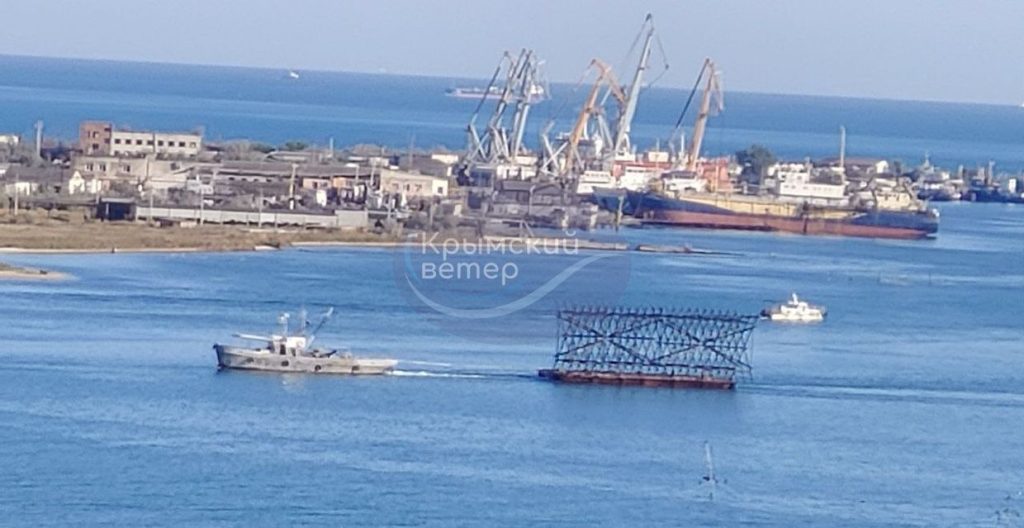Russia is taking measures to strengthen defenses around the Crimean Bridge using underwater drone traps, as reported on September 27. Metal structures have been deployed using barges and a floating crane over the past month, according to the Crimean Wind Telegram channel. An unverified photo showed a barge pulling what appears to be a large section of metal fencing. This development comes after a Navy spokesperson mentioned that Russian forces were constructing a new structure near the Crimean Bridge, which could serve as a defense or another crossing. The bridge, which spans 19 kilometers and was completed in 2018, has been a critical supply route for Russian forces and has been repeatedly targeted by Ukrainian forces in previous attacks.
The Crimean Bridge is at the center of a dispute between Ukraine and Russia at the Permanent Court of Arbitration. Ambassador-at-Large at the Ukrainian Foreign Ministry, Anton Korynevych, stated on September 23 that Russia aims to control the Sea of Azov and Kerch Strait by erecting a barrier to prevent international shipping, while allowing Russian river vessels to pass through. He emphasized that the bridge is unlawful and should be dismantled. Ukraine argues that the bridge was intentionally built low to the water to block international shipping traffic, further exacerbating the tensions between the two countries. The legal battle over the Crimean Bridge reflects the larger geopolitical conflict between Russia and Ukraine over the control of Crimea.
Construction on the Crimean Bridge began after Russia’s illegal annexation of Crimea in 2014 and was completed in 2018. Since then, the bridge has served as a vital link for Russian forces, especially after Moscow’s full-scale invasion of Ukraine. It has been the target of multiple attacks by Ukrainian forces, resulting in significant damage in October 2022 and July 2023. Ukraine has reportedly been testing an underwater sea drone called Marichka, but details about this technology have not been widely disclosed. The development of underwater drone traps by Russia and the use of sea drones by Ukraine indicate the escalating technological arms race in the region, as both countries seek to gain a strategic advantage in the ongoing conflict.
The ongoing legal battle over the Crimean Bridge reflects the broader territorial and geopolitical disputes between Russia and Ukraine. Russia’s annexation of Crimea in 2014 and the subsequent construction of the bridge have been contested by Ukraine, leading to international condemnation and sanctions against Russia. The bridge, which connects Crimea to mainland Russia, has become a symbol of the annexation and a flashpoint in the conflict between the two countries. The recent deployment of underwater drone traps near the bridge signals Russia’s efforts to bolster its defenses and protect this strategic infrastructure from potential attacks by Ukrainian forces.
The tensions surrounding the Crimean Bridge highlight the complex security challenges in the region and the ongoing conflict between Russia and Ukraine. The militarization of the bridge and the use of advanced technology such as sea drones underscore the high stakes involved in this geopolitical dispute. As both countries continue to compete for control over Crimea and the broader Black Sea region, the security situation remains volatile and unpredictable. The deployment of underwater drone traps by Russia and the testing of sea drones by Ukraine represent the latest developments in the technological and military aspects of the conflict, further escalating the tensions between the two nations.
In conclusion, the ongoing developments surrounding the Crimean Bridge and the deployment of underwater drone traps by Russia highlight the intensifying conflict between Russia and Ukraine. The legal battle over the bridge at the Permanent Court of Arbitration reflects the deep-seated territorial disputes and geopolitical rivalries in the region. The strategic significance of the Crimean Bridge as a critical supply route for Russian forces and a symbol of the annexation of Crimea underscores the importance of protecting and defending this infrastructure. The use of advanced technology such as sea drones and underwater drone traps by both countries reflects the evolving nature of modern warfare and the increasing dependence on technological innovation in military strategies. The situation in Crimea and the Black Sea region remains fluid, with the potential for further escalations and confrontations between Russia and Ukraine.


